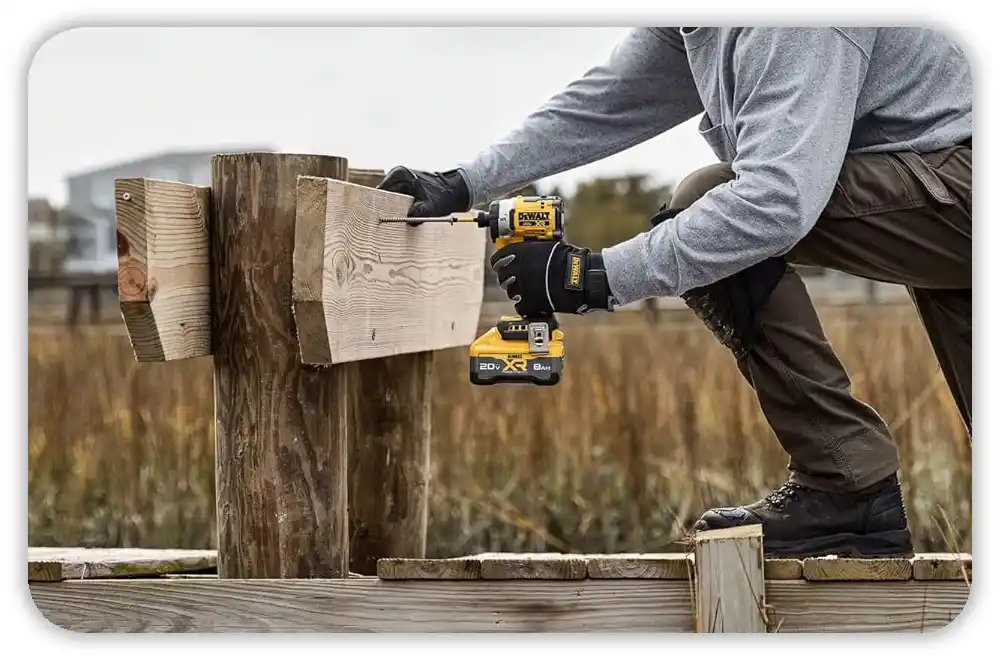When I started doing home projects, I thought a hammer drill and an impact driver were the same thing. They both spin and make noise, right? I learned the truth the hard way.
I tried to drill into a concrete wall with a normal drill. It barely made a mark. Then I turned on the hammer mode—suddenly, the bit started cutting through like magic.
These two tools may look alike, but they’re made for different jobs. Knowing the difference saves time and effort. In this guide, I’ll share what I learned after testing both tools side by side.
Table of Contents
Quick Comparison: Hammer Drill vs Impact Driver
| Feature | Hammer Drill | Impact Driver |
| Main Use | Drilling into concrete or brick | Driving screws and bolts |
| Motion | Spinning with hammer hits | Spinning with torque bursts |
| Best Material | Masonry, stone | Wood, metal, plastic |
| Chuck Type | 3-jaw chuck | ¼-inch hex collet |
| Noise & Vibration | Loud and rough | Quieter, smoother |
| Best For | Hard drilling | Fast screw driving |
Winner:
- Hammer Drill → for concrete and masonry
- Impact Driver → for screws and general work
What Is a Hammer Drill?
A hammer drill spins like a normal drill but also punches forward fast. That hammering action breaks up tough material.

When I used mine on a concrete wall, it tore through with ease. Without hammer mode, the drill just slipped.
Use a hammer drill for concrete, brick, or stone. It’s made for power jobs like hanging shelves or mounting heavy fixtures.
What Is an Impact Driver?
An impact driver gives quick, powerful twists. It drives screws deep without stripping them.
I use mine for building decks, furniture, and frames. It’s light, fast, and easy to handle. I don’t need to push hard, and it drives screws straight every time.
It’s not for drilling holes—it’s for driving screws and bolts fast.
Key Differences: Hammer Drill vs Impact Driver

Power and Motion
Hammer drills use impact hits to drill into hard stuff. Impact drivers use torque bursts to spin screws fast.
Speed and Strength
Hammer drills spin faster. Impact drivers twist harder. A hammer drill wins on concrete; an impact driver wins on screws.
Bits and Chucks
Hammer drills hold round or hex bits. Impact drivers use quick-change ¼-inch hex bits.
Control and Comfort
Hammer drills shake more and need two hands. Impact drivers are smoother and easier to use.
| Factor | Hammer Drill | Impact Driver |
| Power Source | Corded or cordless | Mostly cordless |
| Vibration | High on masonry | Low to moderate |
| Control | Needs firm grip | Easy one-hand use |
| Learning Curve | Moderate | Beginner-friendly |
| Best For | Concrete and brick | Screws and bolts |
Summary:
Hammer drill = hard surfaces.
Impact driver = almost everything else.
When to Use Each

Use a hammer drill when you:
- Drill into brick or concrete
- Mount heavy fixtures
- Install anchors
Use an impact driver when you:
- Build furniture or decks
- Frame walls
- Drive long screws
If you can, keep both. The hammer drill handles the tough stuff. The impact driver does everything else.
Safety Tips
Always wear gloves, goggles, and ear protection. Hammer drills are loud and kick hard. Impact drivers are easier to handle, but still need care.
If it’s cold, your grip can slip—go slow. In humid places, keep tools dry to avoid rust.
Maintenance
Wipe tools clean after use, especially after drilling concrete. Dust kills drills fast.
Keep bits sharp. Charge batteries after every job. Store tools in a dry spot.
Check and replace carbon brushes on corded hammer drills if needed.
Which Should You Choose?
Choose a hammer drill if you work with concrete, brick, or stone.
Choose an impact driver if you mostly work with wood, screws, or bolts.
If you only buy one, get the impact driver. It’s more useful for daily jobs.
Final Thoughts
Both tools are great. The impact driver is best for most people—it’s light, fast, and easy to use.
When you need raw power for concrete or brick, bring out the hammer drill.
Use the right tool, and your projects will go smoother and faster.
FAQs for Hammer Drill vs Impact Driver
What’s the difference between a hammer drill and an impact driver?
A hammer drill works best on concrete and brick. An impact driver drives screws fast into wood or metal. Each tool has its own job for best results.
Can an impact driver drill into concrete?
No. An impact driver doesn’t have a hammering motion. Use a hammer drill for concrete or stone to get clean holes without damaging the tool.
Can I use a hammer drill to drive screws?
You can, but it’s not ideal. Hammer drills are heavy and can strip screw heads. Use an impact driver for smoother, easier screw driving.
Which tool is better for home projects?
For most DIY jobs, an impact driver is easier to use and lighter. If you need to drill into brick or concrete, add a hammer drill to your toolkit.
Do I need both a hammer drill and an impact driver?
If you work on different materials, yes. The hammer drill handles hard surfaces, while the impact driver speeds through wood and screws.

